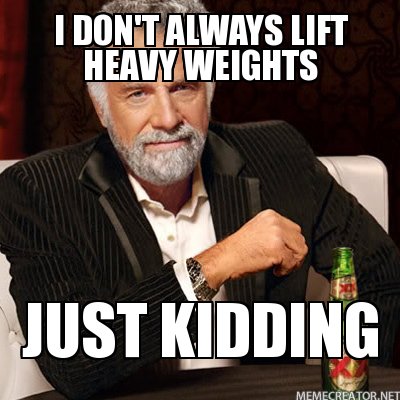The fitness-related content on this site has all been moved over to Strengtheory.com, my new website.
If you want to keep reading on this page, that’s perfectly fine. If you want to read this article on Strengtheory, just replace “gregnuckols” in the address bar with “strengtheory,” and don’t forget to check Strengtheory.com regularly for new articles! If you’d like to share this article with your friends (please do!), then I’d appreciate it if you shared the Strengtheory.com URL. It’s a prettier site for your friends to use, and it helps with the new site’s ranking in search engines.
Go Now!
This is something all new lifters need to read when they’re doing Starting Strength, Stronglifts 5×5, Greyskull LP, or any of the other beginner programs out there.
From a practical standpoint, it’ll help them get the most out of their first couple of years under the bar. Taking the long view, it’ll also be a good introduction to some basic principles of program design.
1. Periodize
Periodization is a massive subject, and it’s easy to get overwhelmed by the minutia. However, in the simplest terms, periodization simply means “having defined times in your training where you emphasize different goals.” The application can get really hairy, but the easiest way to periodize your training without an in-depth knowledge of the theory behind it – changing set and rep schemes.
Yep, it can be that simple.
So, should you periodize your training? In a word: “YES!”
A 2004 meta-analysis essentially showed that periodized training is almost always better than non-periodized training. To quote the authors, “As a result of this statistical review of the literature, it is concluded that periodized training is more effective than non-periodized training for men and women, individuals of varying training backgrounds, and for all age groups.” That’s about the most conclusive statement you’ll hear from an exercise scientist.
Here’s the easiest way to periodize one of the common beginner training programs: instead of sticking with the kosher 3-5 sets of 5 reps for everything, proceed thusly:
Start with 3×8 for your lifts, adding weight each session until you’re unable to do so. Once you can’t add weight every session anymore…
Switch to 5×5. Repeat the process.
Then 5×3.
You don’t have to switch all your lifts over to the new rep scheme all at once. If you plateau on your bench or OHP before your squat or deadlift, go ahead to switch the stalled lift to the new rep scheme, and continue as you were with the others.
This setup allows you to stick with the basic progressive overload you would usually get from a beginner’s program, while also implementing some basic periodization, which will almost certainly make the program more effective for you. You’ll be able to linearly add weight for a longer period of time, and odds are very good that you’ll end up with bigger maxes than if you stuck with 3-5×5 for the entire program.
2. When you finally plateau, add volume
Something I’ve never understood is the stock advice of “when you stall with your linear gains, take 10% off the bar, and build back up using the same progression.”
What’s supposed to happen in the couple of weeks while you build back to your old plateau? Is that when the gains fairy visits to defy the basic principle of progressive overload, thereby granting you a substantially improved response to the exact same stimulus?
Instead, if you decide to stick with the same program, deload a little more than you otherwise would, and build back up with 1-2 more sets per exercise. So if you were doing 3 sets, do 5 sets. If you were doing 5 sets, do 6 or 7 sets. The scientific literature agrees almost unanimously that more volume is better for both strength and hypertrophy. Some studies don’t reach significance, but this is mainly due to lack of statistical power due to small sample sizes (a common problem in this field).
If you want to combine these two pieces of advice, deload to about 10% below where you switched from 3×8 to 5×5. Build back up by proceeding from 5×8 to 6×5 to 7×3. This will more reliably keep your progress going than sticking with 3-5×5, deloading a bit, and building back up with the same sets and reps.
I’m sure if you’re a regular Strength & Science reader, none of this is new to you, BUT it will be new and helpful to a lot of novice lifters. Share it around so they can see better results in their first few months under the bar, and perhaps get their first exposure to the practical application of periodization.


